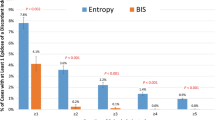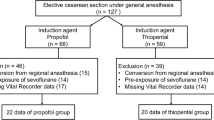Abstract
We describe a case in which an unexpectedly, abnormally low bispectral index value (BIS = 4) and an almost isoelectric electroencephalogram (EEG) pattern were observed during typical induction of anesthesia with propofol. Starting 2 min after the beginning of propofol administration (1.26 mg kg−1), the EEG recordings showed burst and suppression pattern for the next 12 min. The EEG during this period was characterized by gradual prolongation of suppression periods until the appearance of the isoelectric line. After that, burst activity returned and eventually the burst suppression pattern disappeared. We excluded the possibility of ischemic brain damage, and the evidence increasingly points toward a greater sensitivity to propofol. The findings described in this case report support the thesis that there is a wide variability in the responses of patients to propofol that cannot be detected without continuous monitoring of cortical electrical activity.
Similar content being viewed by others
References
S Hagihira M Takasina T Mori T Mashimo I Yashiya (2001) ArticleTitlePractical issues in bispectral analysis of electroencephalographic signals Anesth Analg 93 966–970 Occurrence Handle10.1097/00000539-200110000-00032 Occurrence Handle11574365
IJ Rampil (1998) ArticleTitleA primer for EEG signal processing in anesthesia Anesthesiology 89 980–1002 Occurrence Handle10.1097/00000542-199810000-00023 Occurrence Handle9778016
MR England (1999) ArticleTitleThe changes in bispectral index during a hypovolemic cardiac arrest. Case report Anesthesiology 91 1947–1949 Occurrence Handle10.1097/00000542-199912000-00050 Occurrence Handle10598640
JF Biebuyck R Gouldson M Nathanson P White I Smith (1994) ArticleTitlePropofol: an update on its clinical use Anesthesiology 81 1005–1053 Occurrence Handle7943815
J Van Hemelrijck R Tempelhoff PF White WS Jellish (1992) ArticleTitleEEG-assisted titration of propofol infusion during neuroanesthesia: effect of nitrous oxide J Neurosurg Anesth 4 11–20
BF Matta TS Mayberg AM Lam (1995) ArticleTitleDirect cerebrovasodilatory effects of halothane, isoflurane, and desflurane during propofol induced isoelectric electroencephalogram in humans Anesthesiology 83 980–985 Occurrence Handle10.1097/00000542-199511000-00011 Occurrence Handle7486184
P Ravussin N de Tribolet (1993) ArticleTitleTotal intravenous anesthesia with propofol for burst suppression in cerebral aneurysm surgery: preliminary report of 42 patients Neurosurgery 32 236–240 Occurrence Handle8437662
UM Illievich W Petricek W Schramm M Weindlmayr-Goettel T Czech CK Spiss (1993) ArticleTitleElectroencephalographic burst suppression by propofol infusion in humans: hemodynamic consequences Anesth Analg 77 155–160 Occurrence Handle8317724
B Bissonnette H Swan P Ravussin V Un (1999) ArticleTitleNeuroleptanesthesia: current status Can J Anesth 46 154–168
W Mi T Sakai T Kudo M Kudo A Matsuki (2003) ArticleTitleThe interaction between fentanyl and propofol during emergence from anesthesia: monitoring with the EEG-bispectral index J Clin Anesth 15 103–107 Occurrence Handle10.1016/S0952-8180(02)00510-X Occurrence Handle12719048
M Nakayama H Ichinose S Yamamoto N Kanaya A Namiki (2002) ArticleTitleThe effect of fentanyl on hemodynamic and bispectral index changes during anesthesia induction with propofol J Clin Anesth 14 146–149 Occurrence Handle10.1016/S0952-8180(01)00375-0 Occurrence Handle11943530
Author information
Authors and Affiliations
About this article
Cite this article
Rudner, R., Jalowiecki, P. & Hagihira, S. Abnormally low bispectral index and isoelectric electroencephalogram observed after administration of small doses of propofol during induction of anesthesia. J Anesth 19, 339–342 (2005). https://doi.org/10.1007/s00540-005-0346-9
Received:
Accepted:
Issue Date:
DOI: https://doi.org/10.1007/s00540-005-0346-9




